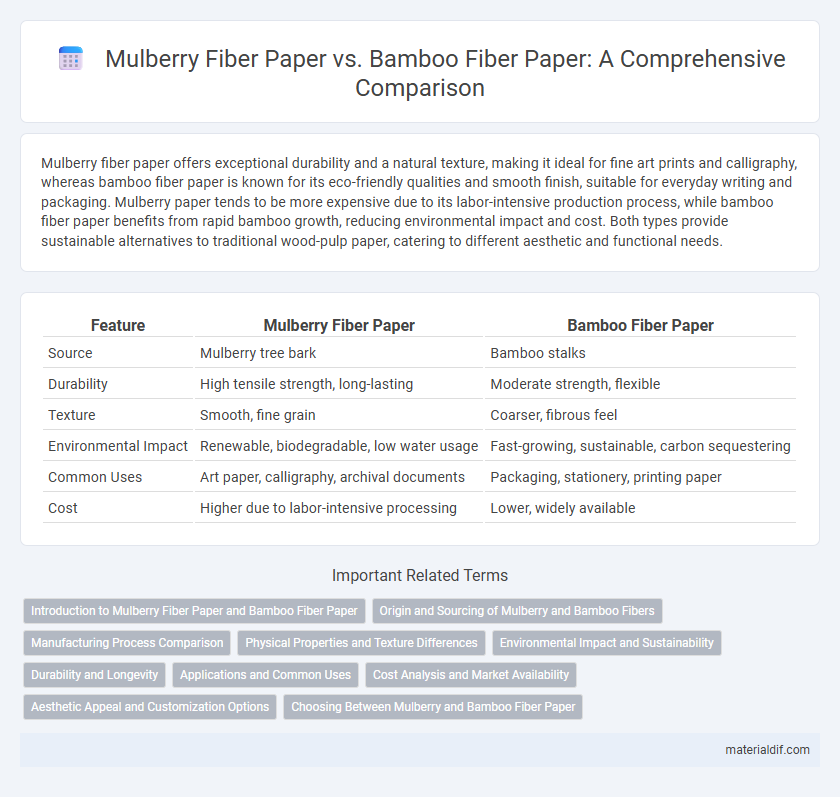Mulberry fiber paper offers exceptional durability and a natural texture, making it ideal for fine art prints and calligraphy, whereas bamboo fiber paper is known for its eco-friendly qualities and smooth finish, suitable for everyday writing and packaging. Mulberry paper tends to be more expensive due to its labor-intensive production process, while bamboo fiber paper benefits from rapid bamboo growth, reducing environmental impact and cost. Both types provide sustainable alternatives to traditional wood-pulp paper, catering to different aesthetic and functional needs.
Table of Comparison
| Feature | Mulberry Fiber Paper | Bamboo Fiber Paper |
|---|---|---|
| Source | Mulberry tree bark | Bamboo stalks |
| Durability | High tensile strength, long-lasting | Moderate strength, flexible |
| Texture | Smooth, fine grain | Coarser, fibrous feel |
| Environmental Impact | Renewable, biodegradable, low water usage | Fast-growing, sustainable, carbon sequestering |
| Common Uses | Art paper, calligraphy, archival documents | Packaging, stationery, printing paper |
| Cost | Higher due to labor-intensive processing | Lower, widely available |
Introduction to Mulberry Fiber Paper and Bamboo Fiber Paper
Mulberry fiber paper is crafted from the inner bark of the Morus alba tree, known for its durability, natural texture, and eco-friendly properties, making it popular in traditional art and calligraphy. Bamboo fiber paper, derived from fast-growing bamboo plants, offers a sustainable alternative with high tensile strength, smooth finish, and resistance to yellowing over time. Both papers serve unique purposes in environmentally conscious industries, with mulberry emphasizing cultural heritage and bamboo highlighting rapid renewability.
Origin and Sourcing of Mulberry and Bamboo Fibers
Mulberry fiber paper is derived primarily from the inner bark of Morus alba trees, which are cultivated extensively in East Asia, especially China and Korea, known for sustainable harvesting that ensures the tree's longevity. Bamboo fiber paper originates from fast-growing bamboo species predominantly found in Southeast Asia, including China and India, where the fibrous stalks are processed into pulp with minimal environmental impact due to bamboo's rapid renewability. Both fibers are sourced through eco-friendly methods, but mulberry's origin from tree bark contrasts with bamboo's grass-like stalk structure, influencing the paper's texture and durability.
Manufacturing Process Comparison
Mulberry fiber paper is produced through a traditional process involving the retting and stripping of mulberry bark, followed by boiling and beating fibers to create a pulp, which preserves the natural long fibers for enhanced durability. Bamboo fiber paper manufacturing employs a chemical or mechanical pulping method to break down bamboo stalks into fibers, resulting in shorter fiber lengths but faster processing times and sustainability benefits due to bamboo's rapid growth. The manufacturing of mulberry fiber paper is more labor-intensive and artisanal, while bamboo fiber paper production leverages advanced industrial techniques for higher volume output.
Physical Properties and Texture Differences
Mulberry fiber paper exhibits a smooth, fine texture with remarkable tensile strength and durability, making it ideal for high-quality artistic and archival applications. Bamboo fiber paper tends to have a coarser surface and higher absorbency, providing excellent ink retention but a slightly less refined finish. Both papers demonstrate superior tear resistance compared to conventional wood-pulp paper, yet mulberry fiber paper offers greater flexibility and resilience under tension.
Environmental Impact and Sustainability
Mulberry fiber paper boasts a lower environmental footprint due to its rapid renewability and minimal pesticide requirement, promoting sustainable forestry practices. Bamboo fiber paper offers high biodegradability and carbon sequestration benefits but requires intensive water usage during processing. Choosing between mulberry and bamboo fiber paper hinges on balancing water conservation with land use efficiency and ecosystem preservation.
Durability and Longevity
Mulberry fiber paper exhibits superior durability due to its strong, long cellulose fibers, making it resistant to tearing and wear over time. Bamboo fiber paper, while eco-friendly and fast-growing, tends to be less durable due to shorter fiber length, resulting in reduced tensile strength. The longevity of mulberry fiber paper is notable in archival applications, maintaining integrity for decades, whereas bamboo fiber paper is better suited for short-term or disposable uses.
Applications and Common Uses
Mulberry fiber paper is prized for its durability and smooth texture, making it a preferred choice for archival documents, fine art prints, and high-quality stationery. Bamboo fiber paper offers superior sustainability and natural antibacterial properties, frequently used in packaging, eco-friendly notebooks, and disposable tableware. Both fibers serve diverse applications, but mulberry excels in premium uses while bamboo dominates eco-conscious and mass-market products.
Cost Analysis and Market Availability
Mulberry fiber paper generally incurs higher production costs due to its labor-intensive harvesting and processing methods, leading to a premium market price compared to bamboo fiber paper. Bamboo fiber paper benefits from the rapid growth and abundant availability of bamboo, resulting in lower raw material costs and broader market accessibility. Market analysis reveals bamboo fiber paper dominates in commercial applications, while mulberry fiber paper maintains niche demand in artisanal and specialty paper sectors.
Aesthetic Appeal and Customization Options
Mulberry fiber paper offers a delicate, natural texture with a translucent quality that enhances artistic and handcrafted projects, making it ideal for high-end invitations and fine art prints. Bamboo fiber paper provides a smoother surface and a sustainable appeal, suitable for eco-friendly branding with diverse customization options including embossing and digital printing. Both papers lend a unique tactile experience, but mulberry excels in organic texture while bamboo prioritizes versatility and environmental consciousness.
Choosing Between Mulberry and Bamboo Fiber Paper
Mulberry fiber paper offers exceptional durability and a smooth texture ideal for fine art and archival uses, while bamboo fiber paper is known for its eco-friendly properties and rapid renewability. Mulberry fibers produce a more flexible and long-lasting sheet, perfect for calligraphy and traditional printing, whereas bamboo fiber paper provides a sustainable choice with a slightly coarser texture suitable for everyday stationery. Selecting between mulberry and bamboo fiber paper depends on the balance of desired strength, environmental impact, and specific artistic or commercial application requirements.
Mulberry Fiber Paper vs Bamboo Fiber Paper Infographic

 materialdif.com
materialdif.com